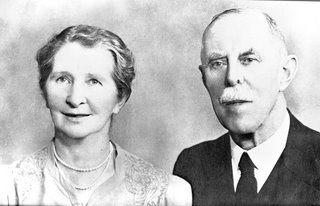 Highlighting the Natural
Highlighting the NaturalIn contrast to the prevailing Australian religious culture that has often highlighted the miraculous, the sensational and the ‘out of this world’, F W Boreham pointed to ordinary things as a rich vein in which truth may be experienced. His encouragement of the ordinary as a valuable sphere of theological reflection was motivated by his personal delight in Dickens, Turner and others who specialized in portraying the ordinary and the public commendation that these artists were given. Boreham was also prompted by the public context of war and depression which limited the availability of money, possessions and travel. The enforced deprivation led Boreham to encourage his readers to discover richness in common objects and everyday experiences.
Reinforcing the view that at any period the ordinary is a largely untapped and unnoticed source of wealth, Myron Orleans, the editor of the
Journal of mundane behavior wrote, “All around us are ordinary phenomena that can astound us if only we attend to them with the seriousness they do not typically receive”.
[1]Astounded by the Ordinary
This astonishment that often emerges out of theological reflection on ordinary things is illustrated in the vocational epiphany of Australian theologian Robert Banks. Recording how his intellectual pilgrimage was influenced by reading an essay by the Scottish author John Baillie on ‘A theology of sleep’, Banks remarked how “Baillie’s juxtaposition of ‘theology’ with something as mundane as ‘sleep’ came as a shock”.
[2] Further reflection and study led Banks to discover the Bible’s invitation to finding God in the routine and to write a theology on ‘All the business of life’.
Readers of Boreham’s essays have commented on experiencing a similar shock at seeing the ordinariness of his subjects.
[3] However, Boreham’s commitment to the study of ordinary things was not only a deliberate adoption of the communication model of Jesus but it enabled him to be viewed along with John Baillie,
[4] Jacques Ellul,
[5] Robert Banks
[6] and a growing number of others as a ‘down-to-earth’ (Banks’ term) theologian intent on fostering a theology and spirituality of everyday life.
Theological Reflection for Everybody
Frank Boreham wrote about ordinary things because he hoped that all his readers, not only professional theologians, might engage in theological reflection. Not only did he express this hope but, as indicated in this chapter, he suggested some tools of theology that included training the vision, trusting one’s own judgement (‘seeing for yourself’), ‘looking through’ things and experiences and combining a contemplative and imaginative approach with rational analysis.
He urged his readers to begin with the ordinary, everyday and commonplace because he recognised that this was an inclusive sphere accessible to all people, not just the preserve of the church or an area mediated by religious specialists. As stated earlier in this chapter, Boreham also hoped that the domain of the ordinary would be a meeting ground for theologians, philosophers and people representing many other disciplines.
[7]Spirituality Grounded in Ordinary Sphere
Demonstrating the importance of this theme for contemporary Australians, David Tacey says, “Australian spirituality is, and will continue to be, grounded in the ordinary events and experiences of daily existence …. If we are looking for the God who produces otherworldly miracles and wonders, He will not necessarily be found in Australia”.
[8] Finding the sacred to be revealed in the ordinary, by ordinary people, indicated for Tacey the “radically democratic God”.
[9]God in All Spheres
An extension of this thinking is that if God can be found in ordinary things, then there is no sphere in which God cannot be experienced. In his editorials, Dr Boreham intentionally blurred the usual dualistic distinctions between the natural and the spiritual, the holy and the profane. While Thomas Keneally’s definition of tea drinking as “the great secular sacrament”
[10] exemplifies the way Boreham sought the sacramental in ordinary things outside the limits of the church, Boreham went further by exploding the ‘sacred’ and ‘secular’ categories to heighten their essential integration.
Knowable in Every Part of Life
A further implication of Boreham’s assertion that the sphere of the ordinary is a primary theatre of spiritual life is the truth that God is eternally present and knowable in every part of the world and universe. As author Elizabeth Dreyer says: “In the past, we may have seen the sacraments as “discrete discharges of grace” into a profane world. But today our theology invites us to see the world as permanently graced at its root, borne up by God’s self-communication whether or not we choose to accept it, whether or not our jaded sensibilities can perceive it”.
[11]Geoff Pound
Image: ‘The great secular sacrament’
[1] Myron Orleans,
Journal of mundane behavior: Mission statement
http://www.mundanebehavior.org/mission.htm, 2000.
[2] Robert Banks,
All the business of life (Sutherland, NSW: Albatross Books, 1987), 9-10.
[3] T H Crago,
Australian Baptist, 13 March 1945. Crago said of Boreham, “He amazes his readers with what he sees in smoke and what he gets out of pockets”.
[4] John Baillie,
Christian devotion (Oxford: Oxford University Press, 1962).
[5]Jacques Ellul,
The presence of the kingdom (London: SCM, 1951).
[6] In addition to the book already cited, Banks has extended his thinking in Robert Banks,
Faith goes to work: Reflections from the marketplace (Washington D C: The Alban Institute, 1993).
[7] Boreham,
Mercury, 9 January 1954.
[8] David Tacey,
Re-enchantment: The new Australian spirituality, 111.
[9] Tacey,
Re-enchantment: The new Australian spirituality, 121.
[10] Tom Keneally,
An angel in Australia (Sydney: Doubleday, 2002), 114.
[11] Elizabeth A Dreyer,
Earth crammed with heaven (New York: Paulist Press, 1994), 173.
 Hidden Treasure
Hidden Treasure



